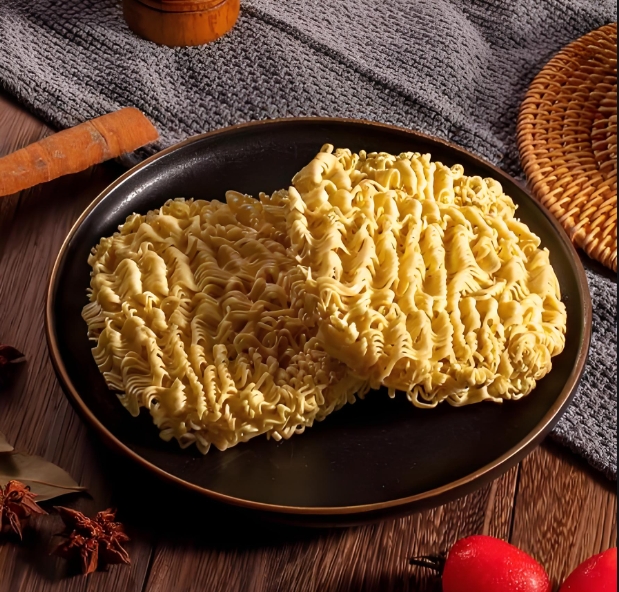The Complete Guide to Producing Fried Instant Noodles: From Ingredients to Packaging
Instant noodles have become a global phenomenon, offering quick, affordable, and tasty meals to billions of people worldwide. Among the various types, fried instant noodles dominate the market due to their distinctive crispy texture, rich flavor, and excellent shelf stability. This comprehensive guide will walk you through the entire production process of fried instant noodles, from raw material selection to final packaging, while highlighting key quality control measures and technological innovations that make this mass-produced food item both delicious and safe for consumption.
Instant noodle making machine
ToggleIntroduction to Fried Instant Noodle Production
The production of fried instant noodles is a marvel of modern food engineering, combining traditional noodle-making techniques with industrial-scale processing. Since their invention in 1958 by Momofuku Ando, instant noodles have evolved into a $50+ billion global industry, with fried varieties accounting for approximately 80% of total production . The frying process not only dehydrates the noodles but also creates the characteristic porous structure that allows for quick rehydration when hot water is added.
Fried instant noodles typically contain about 16-22% oil content after processing, which contributes to their appealing golden color and satisfying mouthfeel . The production follows a carefully orchestrated sequence of steps that transform simple ingredients like wheat flour, water, and salt into the familiar noodle blocks we find in stores. Modern production lines can achieve astonishing speeds, with some facilities producing up to 720 packets per minute , while maintaining consistent quality through automated controls and rigorous safety standards.
What makes fried instant noodles particularly remarkable is their shelf stability—properly packaged products can last about 6 months at room temperature . This longevity, combined with their convenience and affordability, has made them an essential food item in many households and emergency food supplies worldwide. As we delve into the production process, we’ll explore how each step contributes to these desirable characteristics while maintaining food safety and quality standards.
Raw Material Selection and Preparation
The foundation of excellent fried instant noodles lies in careful selection and preparation of raw materials. Quality ingredients not only affect the final product’s taste and texture but also its processing characteristics and shelf life. The primary components include wheat flour, water, various additives, and frying oil—each playing a crucial role in the noodle’s structure and flavor profile.
Wheat flour serves as the backbone of instant noodles, typically constituting 50-60% of the raw materials . Manufacturers prefer special first-grade flour with specific characteristics: a protein content of 10-12% (or wet gluten content of 30-32%), ash content below 0.5%, and stable quality parameters. The flour’s gluten strength directly impacts the noodles’ elasticity and chewiness—qualities highly valued by consumers. Some producers blend in 5-10% starch (usually corn starch) to modify texture and improve processing performance .
Water quality is equally critical, though often overlooked. Ideal processing water should have:
- Hardness below 10 degrees
- pH between 7.5-8.5
- Low iron and manganese content (under 0.1 mg/kg each)
- Alkaline content below 50 mg/kg
This ensures minimal interference with gluten development and prevents undesirable chemical reactions during processing.
Functional additives enhance various aspects of the noodles:
- Salt (1-2% of flour weight) strengthens gluten and adds basic flavor
- Alkaline salts (kansui, typically 0.15-0.2% of flour weight) improve texture and yellow color
- Food phosphates (0.1-0.3%) increase water retention and improve texture
- Guar gum or CMC (0.2-0.4%) enhances viscosity and reduces oil absorption
- Emulsifiers like mono- and diglycerides (0.3-0.6%) help distribute fat evenly
Frying oil selection significantly impacts product quality and shelf life. Refined palm oil dominates the industry due to its:
- High oxidative stability
- Neutral flavor
- Appropriate melting point
- Cost-effectiveness
Some manufacturers blend in small amounts of peanut or other vegetable oils for flavor enhancement. The oil must meet strict quality standards for peroxide value (< 1 meq/kg), free fatty acids (< 0.1%), and moisture content (< 0.1%) before use .
Proper ingredient preparation involves precise weighing and premixing of dry and liquid components. Salt, alkaline salts, and other water-soluble additives are typically dissolved in water first, creating a uniform brine solution. Dry additives like starch and gluten are premixed with flour to ensure even distribution. This meticulous preparation sets the stage for successful dough mixing and subsequent processing steps.
Dough Mixing and Kneading Process
The transformation of raw ingredients into workable dough marks the first major stage in instant noodle production. This critical step determines the fundamental structure and texture of the final product. Modern facilities employ sophisticated mixing technology to achieve consistent, high-quality dough with optimal gluten development.
Industrial-scale dough mixers come in two primary configurations—batch mixers and continuous mixers. Batch mixers, typically with capacities of 500-650 kg per batch, operate in alternating cycles to maintain continuous production flow . These dual-axis machines feature variable speed controls, usually starting with fast mixing (6.5-8 kW motor power) for 1-3 minutes to ensure rapid water absorption, followed by slower kneading (4-5 minutes) to develop gluten structure without excessive mechanical damage . The entire mixing process typically completes in 5-8 minutes at controlled temperatures around 30°C (86°F)—elevated temperatures can prematurely activate enzymes and degrade dough quality.
Continuous mixers represent the cutting edge in noodle production technology. These fully automated systems eliminate the start-stop nature of batch processing, delivering non-stop dough production with superior uniformity. Equipped with precision metering systems for flour and liquid ingredients, continuous mixers maintain exact ratios throughout operation. Spiral conveyors and powder feeders can be integrated to handle multiple formulations automatically, significantly reducing human error and labor requirements .
The dough’s ideal characteristics after mixing include:
- Uniform yellowish color (from alkaline salts)
- Loose, crumbly texture with particle sizes of 3-5 mm
- No visible raw flour or uneven moist spots
- Temperature below 35°C (95°F)
- Proper water absorption (typically 30-35% of flour weight)
Water absorption deserves special attention—insufficient hydration








